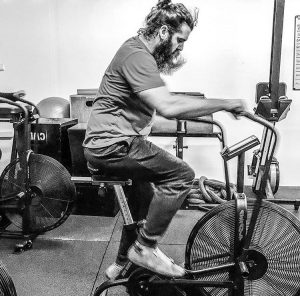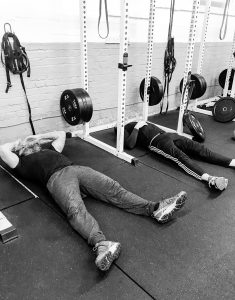
How hard should you go?
I was asked this question the other day in class and it made me think. Of course the brief answer is always ‘it depends’ but I thought about the question in the context of who was asking it and tried to get a little more specific.
There are numerous factors to take into account when providing an answer – gender, biological age, training age, injury history, goals, current stress / recovery levels, where the person is in a given training cycle, are they in-season or off-season, local fatigue / general fatigue, personality and so on…
The guy in question is what the old Crossfit coaches would call a ‘fire breather’. Every gym has them. Guys or girls who will push themselves well beyond their comfort zones and in most cases need a coach to help save them from themselves. They rarely, if ever, need external motivation.
So to preserve anonymity, lets call this person Kev. Kev is a young male with a decent training history but with a recently extended break from training (no injuries). This particular profile is dynamite and a tough one to manage.

‘Kev’ getting after it on the assaultbike
Due to exercise history, gender and biological age, the ability to push beyond current recovery and adaptation levels is a very real concern and a challenge to have to navigate. I have found (bro-science terms) muscle memory is a factor in reaching higher gears but it also has a lot to do with the fact that this individual has prior experience of psychologically hitting those ‘higher’ gears and ‘digging deep’ – a term we like to use here at SDSC. Most novice trainees are unable to do this and tap out long before the risk of overuse / intensity induced injuries – they are self-limiting and injuries at this stage would generally come from mechanical faults as opposed to pushing past adaptation capabilities.
On the analogy of ‘digging deep’, think of pushing hard in terms of digging a hole. A beginner (defined here as someone that has not reached anywhere near their genetic ceiling / potential) will not be able to dig too deep and therefore will get out of the shallow hole that they have dug relatively quickly. A more advanced or at least a stronger trainee will be well down the path of genetic potential and be a lot stronger and can therefore dig a lot deeper. And of course a deeper hole takes longer to climb out of – in terms of recovering within that session and its affect on subsequent sessions.
Again, with the current example it is worth remembering that this individual is not a beginner, although they are starting ‘from scratch’ – therefore caution must be taken with progressions as they can override the self-limiting factor. If adaptive capacities are not respected – by implementing structured programming and sensible progressions, the result will be impending burnout. This is the curse of the new fire breather combined with the novice coach – they become victims of their own success.
For a new coach it is very tempting to see such a trainee lap up everything you throw at them as they get stronger. The initial significant improvements in performance encourage the tendency to push harder and continue to throw more and more at the athlete. It is always these individuals that coaches pin their successes to (until the blow out) where, in the current gym climate, social media likes are currency. It is tempting to put these folks at the front line to show off the successes of your ‘systems’ but truth be told, these individuals could walk into any gym and make any program look good – to a point.
The real challenge is to keep these individuals making progress long term. How often, even at the highest levels of Crossfit or other renowned gyms, have we seen one individual become the poster boy / girl for that gym, continue to dominate workouts and display ever improving feats of strength and fitness only to one day disappear – and maybe come back re-invented or more precisely forced into a more balanced way of training (Greg Amundson or Gillian Mounsey anyone??). Unfortunately this cycle of burn out is all too common, every gym has that person, they are all over social media crushing workouts and then one day they are gone. But it doesn’t have to be this way.
Managing fire breathers involves skilled coaching – it takes more then memorising the pages of a training manual. This is why I believe effective coaching will never become fully automated. It is a craft that requires skill that takes decades to cultivate and hone (almost like a skilled chef – adding just the right amount of ingredients). Increased awareness will build a safer scenario where the trainee can be pushed and feel like he is pushing himself but not to the point beyond which he can recover. This involves the discretion and judgment of the coach to be able to ‘rein in’ the athlete when needed and ideally before things start to regress or fall apart.

The calm after the storm
You can program a seemingly airtight training cycle but things happen and at times it is just necessary to unshackle the individual and let them set themselves on fire. Leader boards are great for this and an excellent motivational tool but at the same time, the right must be earned to use them – and this takes confidence on the coaches part, being able to stand up to an eager individual and ‘hold them back’ for their own good. Sometimes you may lose an individual if they feel they are not being pushed but at the end of the day a coach’s primary aim is to ‘do no harm’. I would personally rather lose a member if they felt they were being held back as opposed to losing someone through an injury or burn out. But again, clear lines of communication and transparency are needed so as to build trust in the processes and the methodology of the coach and gym.
The other side of this coin is that you can wrap an individual in cotton wool and restrict their need to punish themselves from time to time, which can lead to frustration over time. Again this is very much an individual call – some individuals may be experiencing an extremely stressful day / period in their life and extra training stress can push them over the edge OR letting them push hard in a session can release stress. Again, this is something a perceptive coach will be able to determine through looking at various cues and communicating with the trainee.
So, in terms of the original question – it depends. It takes practice and knowing your athletes / members / clients and communicating with them and looking for signs – mentally and physiologically. Also the more time spent with an athlete, much like any relationship, a better understanding and level of trust is reached – as long as both parties communicate to the best of their abilities consistently. There must be transparency in a program and in my experience, members have responded far better when they have had the training cycle explained clearly to them and uncovering the ‘why’s’ of a specific plan in the process. This increases buy-in and trust. It is worth mentioning too that ego must be controlled on both sides – I would say there should be a lack of ego but I don’t know if this is possible or beneficial, this topic is another blog post in itself!
It is also worth reiterating that health and performance are two different things – how hard do you ‘need’ to go? Some folks ‘need’ to feel that discomfort in their training, others don’t. This is part of the essence of the individual and must be respected too. As long as multiple factors are lined up to allow periods of ‘running the red light’, it can be absolutely a good thing to get after it but even over the course of a training cycle or beyond, a change of pace and gears is needed. This will allow progress over the long term, which is the ultimate goal. Anybody can make someone train to the point of exhaustion or nausea but numerous factors must be considered if this is deemed beneficial or acceptable at any stage during a training cycle. Sometimes it is. This comes down to communication and trust built between coach and trainee and ultimately metrics. Making sure progress is being made. And always finding fulfilment in the journey – so the ‘why’s’ should always be explored too.
————————————-
The above are some ramblings and observations I have made in my own time coaching, I am always willing and probably too keen to discuss further with people here, on emails or in person, so feel free to get in touch! – Dave
